


The Neuburg Castle (German: Schloss Neuburg) is a palace in Neuburg an der Donau, Upper Bavaria.



The Neuburg Castle (German: Schloss Neuburg) is a palace in Neuburg an der Donau, Upper Bavaria.
The original castle was built in the early Middle Ages by the Agilolfings. This was acquired by the Wittelsbach dukes in 1247.
When Count Palatine Otto Henry began his rule in Palatinate-Neuburg in 1522, he found a medieval fortified castle in his residence city of Neuburg, which, unlike similar princely residences was still not adjusted for the demands of a modern court. So from 1527 he ordered to re-design the castle into a Renaissance palace and to expand the artistic quality and condition to one of the most important palaces of the first half of the 16th Century in Germany. From 1537 an additional west wing was added which also includes the chapel.
The chapel is the oldest newly built protestant church in the world, although construction of the shell began as a catholic court chapel in 1537, with a small apse, in which the altar with a crucification group, commissioned in 1540, is placed. In 1541 elector Otto Henry converted to the new Lutheran protestantism, and from 1542 the Salzburg church painter Hans Bocksberger der Ältere lavishly decorated the chapel with painted ceiling vaults and galleries in the latest antique-style Italian manner. The picture program not only thematized the decisive role of Christ as divine guarantor of grace, the central lutheran doctrine. It also claims a decisive role of the prince in the distribution of this grace within a God-given earthly order. The court chapel was consecrated on 25 April 1543 by the reformed theologian Andreas Osiander. It was thus the first newly built protestant church, an honor often attributed to the court chapel of Hartenfels Castle at Torgau which was built in 1443-44 and consecrated by Martin Luther on 5 October 1544.
Because of the financial difficulties and bankruptcy of Otto Henry in 1544, the construction of the west wing of the castle took a long time. Wolfgang, Count Palatine of Zweibrücken, who succeeded his cousin Otto Henry in the Duchy of Palatinate-Neuburg, ordered in 1562 to decorate the west wing facing the courtyard with elaborate Sgraffito decorations. The Knights' Hall (the lower panel room in north building) was provided in 1575 by Hans Pihel with a coffered ceiling and wall panels from a rotating timber, both of which are original. The impressive east wing was rebuilt in 1665 by Philip William, Elector Palatine in the Baroque style and complemented with two round towers.
Today the castle houses a gallery of baroque paintings, the museum is under supervision of the Bavarian State Picture Collection.

The Electoral Palatinate or the Palatinate, officially the Electorate of the Palatinate, was a constituent state of the Holy Roman Empire. The electorate had its origins under the rulership of the Counts Palatine of Lotharingia in 915; it was then restructured under the Counts Palatine of the Rhine in 1085. From 1214 until the Electoral Palatinate was merged into the Kingdom of Bavaria in 1805, the House of Wittelsbach provided the Counts Palatine or Electors. These counts palatine of the Rhine would serve as prince-electors from "time immemorial", and were noted as such in a papal letter of 1261; they were confirmed as electors by the Golden Bull of 1356.

The House of Wittelsbach is a former Bavarian dynasty, with branches that have ruled over territories including the Electorate of Bavaria, the Electoral Palatinate, the Electorate of Cologne, Holland, Zeeland, Sweden, Denmark, Norway, Hungary, Bohemia, and Greece. Their ancestral lands of Bavaria and the Palatinate were prince-electorates, and the family had three of its members elected emperors and kings of the Holy Roman Empire. They ruled over the Kingdom of Bavaria which was created in 1805 and continued to exist until 1918.

Frederick V was the Elector Palatine of the Rhine in the Holy Roman Empire from 1610 to 1623, and reigned as King of Bohemia from 1619 to 1620. He was forced to abdicate both roles, and the brevity of his reign in Bohemia earned him the derisive sobriquet "the Winter King".

Heidelberg Castle is a ruin in Germany and landmark of Heidelberg. The castle ruins are among the most important Renaissance structures north of the Alps.

Neuburg an der Donau is a town which is the capital of the Neuburg-Schrobenhausen district in the state of Bavaria in Germany.

The Residenz in central Munich is the former royal palace of the Wittelsbach monarchs of Bavaria. The Residenz is the largest city palace in Germany and is today open to visitors for its architecture, room decorations, and displays from the former royal collections.

Frederick III of Simmern, the Pious, Elector Palatine of the Rhine was a ruler from the house of Wittelsbach, specifically the cadet branch of Palatinate-Simmern-Sponheim. He was a son of John II of Simmern and inherited the Palatinate from the childless Elector Otto-Henry, Elector Palatine (Ottheinrich) in 1559. He was a devout convert to Calvinism, and made the Reformed confession the official religion of his domain by overseeing the composition and promulgation of the Heidelberg Catechism. His support of Calvinism gave the German Reformed movement a foothold within the Holy Roman Empire.

The Duchy of Palatinate-Zweibrücken was a duchy of the Holy Roman Empire with full voting rights to the Reichstag. Its capital was Zweibrücken. The reigning house, a branch of the Wittelsbach dynasty, was also the Royal House of Sweden from 1654 to 1720.
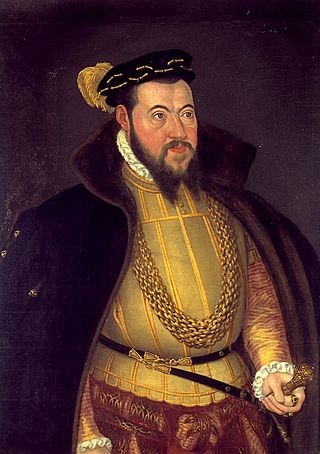
Count Palatine Wolfgang of Zweibrücken was member of the Wittelsbach family of the Counts Palatine and Duke of Zweibrücken from 1532. With the support of his regent, his uncle Rupert, Wolfgang introduced the Reformation to Zweibrücken in 1537.

Palatinate-Neuburg was a territory of the Holy Roman Empire, founded in 1505 by a branch of the House of Wittelsbach. Its capital was Neuburg an der Donau. Its area was about 2,750 km2, with a population of some 100,000.

Wolfstein is a town in the Kusel district in Rhineland-Palatinate, Germany. Before 1 July 2014 it was the seat of the like-named Verbandsgemeinde, since then it is part of the Verbandsgemeinde Lauterecken-Wolfstein. Wolfstein is known for its two castle ruins, Neu-Wolfstein standing over the heart of the town, and Alt-Wolfstein standing at the narrowest spot in the Lauter valley at the town's northern entrance. Wolfstein is a state-recognized recreational resort (Erholungsort).
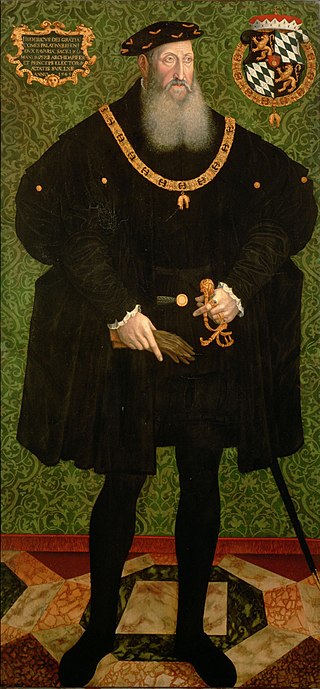
Frederick II, Count Palatine of the Rhine, also Frederick the Wise, a member of the Wittelsbach dynasty, was Prince-elector of the Palatinate from 1544 to 1556, and pretender to the Norwegian Throne from 1535 to 1556.
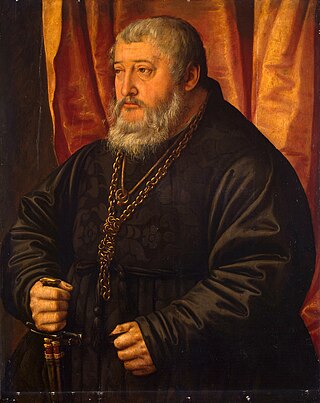
Otto-Henry, Elector Palatine, a member of the Wittelsbach dynasty was Count Palatine of Palatinate-Neuburg from 1505 to 1557 and prince elector of the Palatinate from 1556 to 1559. He was a son of Rupert, Count Palatine, third son of Philip, Elector Palatine; and of Elizabeth of Bavaria-Landshut, daughter of George of Bavaria.

The War of the Succession of Landshut resulted from a dispute between the duchies of Bavaria-Munich and Bavaria-Landshut (Bayern-Landshut). An earlier agreement between the different Wittelsbach lines, the Treaty of Pavia (1329), concerned the law of succession and stated that if one branch should become extinct in the male line then the other would inherit. This agreement disregarded imperial law, which stipulated that the Holy Roman emperor should inherit should a line fail.

Ruprecht, Count Palatine of the Rhine, was the third son of Philip, Elector Palatine of the House of Wittelsbach and he was Bishop of Freising from 1495 to 1498.
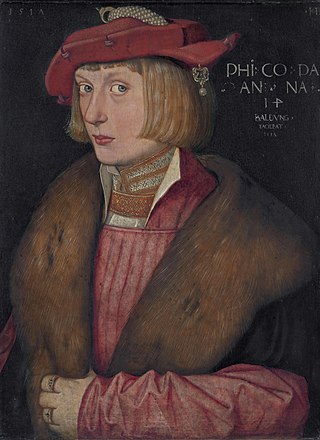
Philip the Contentious, a member of the Wittelsbach dynasty, was a titular Count Palatine of the Rhine and ruling Duke of Palatinate-Neuburg from 1505 to 1541.

Marie of Brandenburg-Kulmbach was a Princess of Brandenburg-Kulmbach and by marriage Electress Palatine.

Wittelsbach Castle was a castle near Aichach in today's Bavarian Swabia.
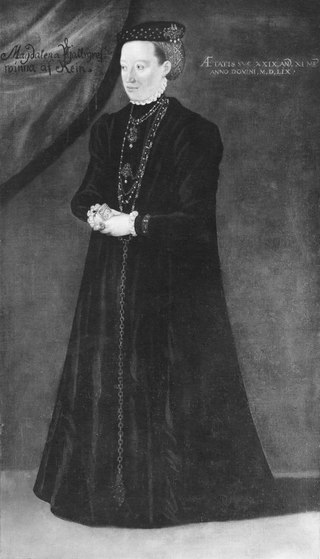
Anna of Hesse was a princess of Hesse by birth and marriage Countess Palatine of Zweibrücken.